Spring 2016 A publication of the Wildlife Division—Getting Texans Involved
 It's Raining! Now What?
It's Raining! Now What?
By Mark Klym
There were some brief periods when it looked like things were changing—in central Texas we had the Halloween flood and the Memorial Day flood-but these were short lived and when the waters receded we returned to drought conditions. East Texas and coastal Texas is now underwater. In the Pineywoods, bottomland hardwood forests get an important influx of nutrients, and summer nesting songbirds and ducks have plenty of choices for nesting and feeding habitat. On the coast, rains mean saltwater marshes now find themselves full of freshwater, which drastically alters the fish and wildlife community in those habitats, which can be both good and bad.
It appears now that most of the state is out of the drought. At the time of writing, 74% of the state was in no stage of drought while a year ago this number was 51%.
How do these swings affect wildlife and habitat management? Does it bring any challenges? Opportunities? In this issue, we explore some of the things we see as Texas moves from drought to "normal" water situations and how land managers can make the transition a little easier. From brush management to bird feeding, the additional moisture brings changes, and our authors explore what you can do for wildlife at home or on your land.
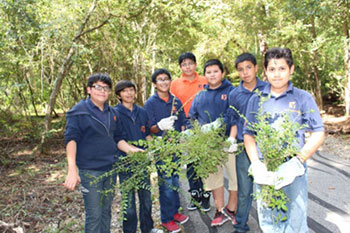 Wet Weather and Invasives
Wet Weather and Invasives
By Teri McArthur & Rose Belzung Holmes
All over Texas, the Invaders of Texas program helps to organize, train, and support these volunteer efforts. To ensure the program's success at Jesse H. Jones Park & Nature Center in Humble, training sessions for new volunteers are held annually within the park while monitoring and removal events are held monthly. Reminders, updates, and successes are sent to promote the program to current and potential volunteers. This is just one example of how parks and other areas are turning to volunteers to improve wildlife habitat by controlling pest species. While many of the park’s volunteers are Texas Master Naturalists, others are concerned residents who read about the program in their local newspaper. Wherever you are, encourage youth to work with adult volunteers as part of a clean-up crew during invasives removal, which multiplies your work force and gives the young volunteers a chance learn the importance of conservation work.
Scout groups use invasive removal to meet the requirements for advanced awards related to environmental improvement activities. Efforts go far beyond maintaining a trail and offer opportunities to complete remediation projects to improve environmental quality and health. The process of locating and recording the presence of invasive plants, then accomplishing removal and disposal, followed by replanting with natives results in broad scale ecosystem restoration.
During wet periods, many invasive plants are easier to remove – sometimes getting all of the root system and preventing new sprouts. However, during these periods, invasive species spread readily. Why not take this opportunity to remove these species before they become more pervasive?
To learn more about the Invaders of Texas program please visit http://texasinvasives.org/invaders.
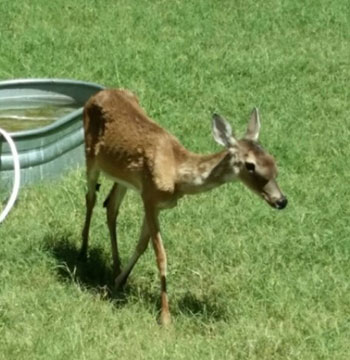 Increased Internal Parasite Loads in White-tailed Deer in Central Texas during Summer 2015
Increased Internal Parasite Loads in White-tailed Deer in Central Texas during Summer 2015
By Elizabeth Bates
Comal County was one of several counties that experienced this phenomenon last summer. Texas Parks and Wildlife Department biologists from neighboring counties received similar phone calls. The deer were described as skinny or emaciated, several had diarrhea, and most were lethargic. Also, the majority of the calls were coming from urban or suburban residents who resided in areas with high deer densities. After consulting with our staff veterinarian and collecting fecal samples from the sick deer, we determined the deer were suffering from heavy infestations of internal parasites. What brought on these heavy infestations? Well as it turns out there were a couple of factors at play that reated ideal conditions for parasite development and transmission during the spring and summer of 2015.
The first factor involves the life cycle of the parasites. The majority of the parasites were nematodes that reside in the gastro-intestinal tract of deer (stomach worms). In general, eggs from these parasites are passed out of the host with fecal material. Given the right environmental conditions, which includes warm wet weather, the eggs hatch into larvae and the larvae move to vegetation on the ground where they are consumed by another host. The larvae are not able to move very high up on the vegetation so areas that are overgrazed or mowed can increase exposure rates of hosts to the larvae and contribute to infection. After a couple of weeks inside the host, the female nematodes begin to lay eggs and the life cycle starts over. Some species of nematode, such as Haemonchus contortus or barber’s pole worm, can lay up to 10,000 eggs per day and have the potential to spread rapidly. The drought over the past several years likely kept these stomach worms at relatively low numbers. However, heavy rains this past spring coupled with the warm and humid weather produced favorable conditions for larvae development.
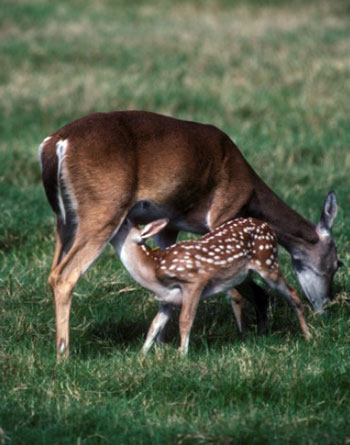
So why were the majority of reports concerning sick deer coming from urban and suburban areas? One obvious answer is that deer in these areas are more visible to the public and therefore residents are more likely to report the deer. However, urban and suburban areas typically experience high deer densities. These high deer densities are often the result of food availability (often in the form of landscaping and supplemental feeding), a lack of natural predators and limited or no hunting. The local overpopulation of deer results in high fecal loads on the nicely mowed and manicured residential properties. This can result in high parasite transmission among deer especially since the deer are often eating in the same areas where they defecate. Often, deer in urban and suburban areas are fed by some of the residents. This results in the concentration of deer at feeding sites and increases the risk of disease and parasite transmission. Certain stressors can make deer more susceptible to parasites such as nursing, old age and being young and growing. However, even healthy deer can succumb to stomach worms if the parasite load becomes high enough.
In conclusion, rains during the spring of 2015 brought some much needed relief from the drought experienced by most of Texas over the last several years. However, the rains also created favorable conditions for parasites, particularly stomach worms. These parasites are a natural part of the ecosystem with populations that fluctuate with changing environmental conditions. However, human influences on the natural system have led to high deer densities allowing for situations where parasite populations can explode. These situations are often magnified in urban and suburban environments where deer are more visible and living in unusually high densities.
Elizabeth Bates, PhD is a Wildlife Biologist with Texas Parks and Wildlife working in Comal and Kendall Counties.
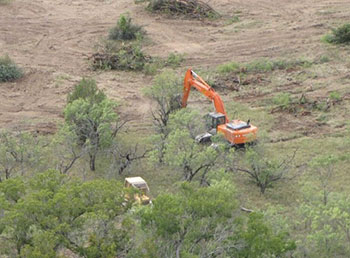 Brush Management In Rain and Drought
Brush Management In Rain and Drought
By James Gallagher
Before we jump off into some examples, let's take a minute to discuss strategy. Generally speaking, we proceed in 3 steps: what condition are we trying to correct (e.g., too much woody cover); how much country are we trying to treat (individual plants versus broadcast); what tools will work on the chosen landscape, season, etc. (e.g., plows don't work well in shallow soil). Cost will also affect our decision, but should really come into play only after we have completed the first 3 steps.
Provided you have put in the necessary effort to plan your management activities, have identified a desired outcome and appropriate techniques, then it is also possible to reap benefits from both good and not-so-good growing conditions out on the range. We don’t normally think of good things coming out of a drought but it is possible to learn some things if you pay attention!
During all but the most severe droughts, woody plants, with their deeper roots, will continue to grow long after herbaceous plants have given up. Some of these mottes can be successfully trimmed and sculpted during this time to improve habitat later on. Don’t neglect the old fashioned approach; hand cutting and hand spraying a little at a time adds up! You get to choose carefully when you are felling trees with an axe! Progress is slow, but you had lots of time to consider where, when and how many along the way! These days we can choose to treat a single plant, or we can treat hundreds of acres in a single day. If anything, it is even more important to consider the where, when and how many than ever before!
Normally we don't see much new seedling establishment during a drought, but seed dispersal by livestock can set the stage when the rains return (think mesquite beans germinating in cowpies!). These seedling plants will be more vulnerable to many control techniques during the first couple years of their lives, so make sure to do something about them before they get away! If you can defer grazing for a while then prescribed burning will take care of most of them. If that is not an option, or if fine fuels are still lacking, herbicide treatments are less expensive and easier when woody plants are small.
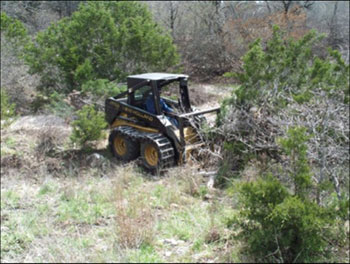
Sometimes during a drought even woody plants die. This is a mixed blessing, depending on what plants die, but when woody plants die in a group it often create an opportunity for management. These areas might be reclaimed with the application of prescribed fire and maintained in a more open condition thereafter. It is also possible to manage such situations with smaller equipment than you would need for healthy growing plants. Sometimes simply knocking plants down and crushing them will be enough to provide more forage and usable habitat for wildlife.
It is perhaps even more important to pay attention to where the animals on the range are going during the drought. They will show which plants are most important to them for food and shelter and how far they are willing to live from a water source!
Once the rains return there are still more opportunities. Softer soil makes it easier to uproot and overturn plants, making mechanical techniques more efficient. Also, moist soil allows herbaceous plants to quickly cover up the tracks left behind by mechanical equipment. Another benefit of good growing conditions is that it increases the effectiveness of herbicide treatments, since stressed plants will not absorb and transport as well. Plus, faster growing plants will begin to show effects from herbicides more quickly which always makes us feel better about the treatment.
Good rains produce forage! Prescribed grazing is still a new idea to many, but means that you choose the proper type of livestock for the problem you are addressing and apply at the time and place where it will do the most good…and then remove the livestock. This can be tough to achieve with most traditional ranch operations, but it can be done. It may require new fencing, or creative leasing, so use your imagination and what you have available.
Good growing conditions also make it easier to save some fuel for prescribed fires. Normally you need to defer grazing for at least one growing season, but that can vary. Prescribed fire can be used to renew a stand of grass, remove dead and down material, clean up brush piles, suppress woody plants, and even open up stands. Don’t forget that sometimes we can combine techniques for greater effectiveness. This may mean spraying some plants before or after burning, or it could mean turning livestock into a recently burned area to eat down the prickly pear cactus after the thorns have been burned off.
Brush management still includes some art to go with the science and sometimes you have to get creative to achieve your desired result. Remember, the goal is to improve habitat. If you apply management and walk away, something will happen but it may not be what you wanted. The real key, though, is to keep at it, keep your eyes open, and learn as you go.
Dr. Jim Gallagher is a Wildlife Biologist at the Mason Mountain Wildlife Management Area in Mason, Texas.
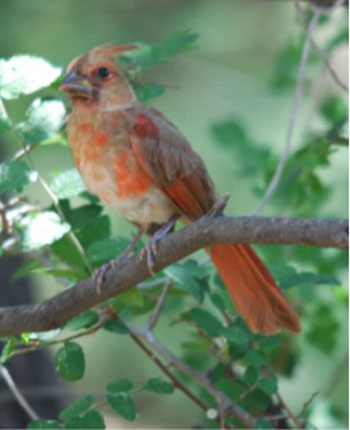 Do Americans Love Their Birds To Death?
Do Americans Love Their Birds To Death?
By Scott E. Henke
The problem arises because providing seeds to birds may be harmful due to mycotoxins, of which aflatoxins are the most widely occurring and dangerous mycotoxin. Aflatoxins are a by-product of common flavus soil fungi; the two most common fungi are Aspergillus flavus and Aspergillus parasiticus. Any cereal grain that is used in the mix of bird seed is susceptible to the growth of these fungi, but peanuts, corn, and cottonseed are the three crops most often affected by aflatoxin.
Aflatoxin is dangerous to animals, including humans, because it can cause cancer, genetic mutations, and birth defects. Aflatoxins also negatively affect metabolism resulting in weight loss, and can reduce immune system functions resulting in poor general health. Smaller animals appear to be more susceptible to the effects of aflatoxin than larger animals, and birds appear to be more susceptible than mammals. Therefore, and unfortunately, songbirds at backyard feeders find aflatoxin to be highly toxic. A bird doesn’t have to eat much contaminated grain to experience ill effects of aflatoxin. Because of the health problems associated with grain consumption that is contaminated with aflatoxin, the Texas State Feed and Fertilizer Control Service based out of Austin, Texas, recommends that grain with aflatoxin levels > 50 parts per billion (ppb) not be fed to wildlife. The European Union enforces much stricter standards, requiring < 5 ppb in animal feeds. However, even though recommendations are in place, feeding aflatoxin-tainted grain to birds still occurs.
The problem is that aflatoxin can be very tricky stuff. Fungi growth, and consequently aflatoxin production, can occur while the grain is still growing in the field, it can occur during the harvest process, and it can occur while the grain is in storage. Weather conditions can play an important role. Fungi growth is encouraged by warm and humid climates; however, it can occur in cooler and dry climates as well. Grains that are broken in the harvest process or exposed to insect infestation during growth or in storage are more susceptible to fungi growth, hence potential aflatoxin production. Grain needs to be maintained in a dry environment because once grain moisture content reaches 13% or greater, fungi growth can occur. Even bags of grain labeled as ‘aflatoxin-free’ or ‘contains < 20 ppb aflatoxin’ may no longer be true once the grain is packaged. The label actually is only valid for the day the grain was tested because fungi growth can occur while in storage. In fact, the aflatoxin content within a bag of grain can vary, with some parts of the bag being substantially higher or lower than others in the same bag. This occurs because fungi growth on the grain does not occur uniformly throughout the entire bag. Instead fungi growth, and hence potential aflatoxin production, occurs in hotspots within a bag. If a 'hotspot' is sampled, then the aflatoxin content may appear high. However, if a ‘hotspot’ is missed and not contained within the tested sample, then the aflatoxin content of the grain may appear within the safe range to feed to animals. This game of cat and mouse can be frustrating to the consumer who wants to avoid feeding aflatoxin-contaminated grain to birds, but it is a realism that consumers must understand and accept.
Just how serious is the aflatoxin problem when considering the feeding of songbirds at backyard feeders? Investigators with the Caesar Kleberg Wildlife Research Institute (CKWRI) at Texas A&M University-Kingsville, Drs. Scott Henke and Alan Fedynich, wanted to find out. They traveled throughout Texas and randomly purchased bags of bird seed from grocery stores, retail stores, pet shops, and grain cooperatives and tested the aflatoxin levels within the bags. What they found was surprising; 17% of the 142 bags contained aflatoxin concentrations >100 ppb. Levels of aflatoxin within the samples ranged from non-detectable to an astounding 2,780 ppb!
The two investigators teamed up again to determine the acute effects of aflatoxin consumption on northern cardinals, a favorite species at backyard feeders and an iconic bird species often displayed on Christmas cards. Sadly it was determined that a one-time dosage >500 ppb would kill a cardinal within 24 hours due to liver toxicity and kidney failure. However, a more alarming finding was that dosages deemed safe (< 50 ppb) actually suppressed immune system functions. Suppression of the immune system makes the body much more susceptible to diseases and infections that typically do not cause illness or death, very similar to the way the AIDS virus affects the body. Therefore, the CKWRI researchers discovered that feeding songbirds one-time, low dosages of aflatoxin-contaminated grain could have detrimental consequences.
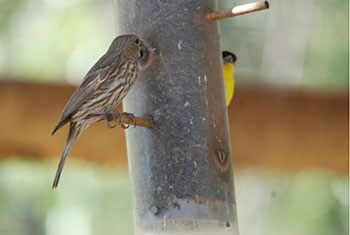
So does this mean that Americans should stop feeding birds? Although that option could prove to be safer for birds, the decision doesn't have to be so extreme. There are things you can do to help reduce the risk of feeding aflatoxin-contaminated grain to songbirds. First, purchase bird seed from stores where bags don’t sit on the shelf very long. Remember aflatoxin production potentially can continue even while the seeds are in a bag sitting on a shelf in a store. Purchase birdseed in small quantities that can be used within a short period of time. This will further reduce the time the grain is in storage. Also, remember to keep your birdseed in a dry environment to lessen the likelihood of fungi growth. Fill your feeders with just enough seed that can be consumed by birds within 1-2 days. Seeds that are exposed to humidity, rain, or morning dew are more likely to become moldy and have a greater risk for aflatoxin production if left in feeders for a week or more. Lastly, I recommend you clean your bird feeders once a week with a 14% bleach solution, which can be reached by adding 1 cup bleach for each 6 cups water. Other sources online typically advocate a 10% bleach solution. However, once again, Dr. Fedynich and I teamed up to discover that a 10% bleach solution was not adequate to completely kill the fungus. A 10% bleach solution would kill the fungal colony, which gives the appearance of killing the mold, but the microscopic spores were untouched by 10% bleach and could reproduce a new fungal colony within 5 days after the cleaning. However, a 14% bleach solution would kill the colony and spores. Remember to scrub the corners of the feeders because those small nooks and crannies make for wonderful hiding places for fungi. Rinse your feeders and thoroughly dry them before you add more seed. This point is critical because it would do no good placing dry seeds on a wet surface, because doing so would create a scenario that actually enhances fungi growth.
Americans enjoy their birds, but let's keep them safe while doing so.
Scott Henke, PhD., is a Regents Professor and Chair of the Department of Animal, Rangeland and Wildlife Sciences, and a researcher with the Caesar Kleberg Wildlife Research Institute at Texas A&M University-Kingsville.
Back Porch
By Richard Heilbrun
TBut recent nation-wide efforts may change the forecast. Over the past year, the “Blue Ribbon Panel on Sustaining America’s Diverse Fish & Wildlife Resources” has been studying the problem of inadequate funding that hampers the ability of state fish & wildlife agencies to manage our most imperiled, sensitive populations. Their final recommendation was that Congress dedicate up to $1.3 billion annually in existing revenue from the development of energy and mineral resources on federal lands and waters to the Wildlife Conservation Restoration Program. The good news is that this funding mechanism would not necessitate a new tax, and it would be sufficient funds to effectively implement all 50 state wildlife action plans! At the national level, this means significant progress on more than 12,000 Species of Greatest Conservation Need.
The Blue Ribbon Panel is continuing their efforts after their March announcement, and they expect to get legislation introduced in early 2017. You will be seeing a lot more about this throughout the next 18 months.
This new funding mechanism, if implemented by the US Congress, would be a game changer for those non-hunted species that we call care about. It also means significant help for the conservation community in Texas, including nature education, habitat management, incentive programs, and species-specific research to help guide recovery efforts. We look forward to providing you regular updates about the Blue Ribbon Panel’s progress. With a little help from Congress, the forecast may be optimistic for Texas and her most sensitive species.
Richard is a Wildlife Biologist and Conservation Outreach Program Leader with TPWD.

 Texas Parks and Wildlife Department, 4200 Smith School Road, Austin, TX 78744
Texas Parks and Wildlife Department, 4200 Smith School Road, Austin, TX 78744


